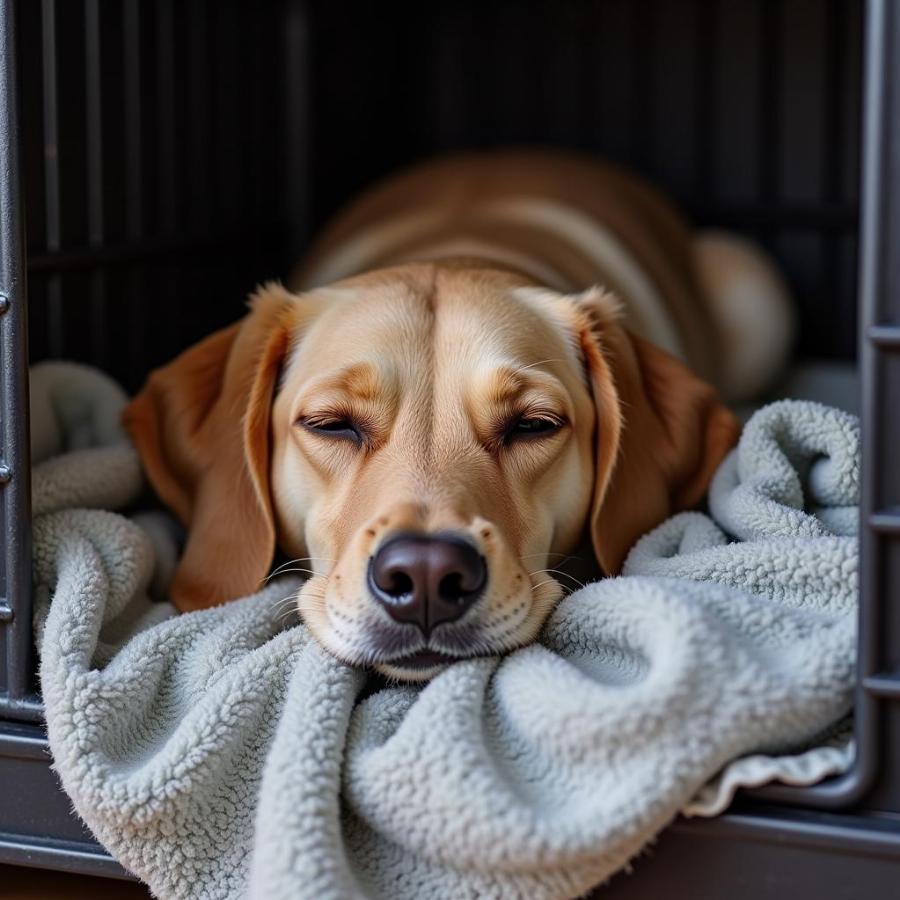Crate training an older dog can seem daunting, but with patience and the right approach, it can be a successful and rewarding experience for both you and your furry friend. Many people assume crate training is only for puppies, but older dogs can benefit too. Whether you’re introducing a newly adopted senior dog to your home, dealing with separation anxiety, or simply looking to provide a safe and secure space, this guide will equip you with the knowledge and tools to crate train your older dog effectively.
Understanding the Benefits of Crate Training for Older Dogs
Crate training offers numerous advantages for older dogs. It provides a den-like sanctuary where they can feel safe and secure, reducing anxiety and promoting relaxation. A crate can also be invaluable during house training, preventing accidents and establishing a routine. For older dogs with medical conditions, a crate can offer a comfortable space for rest and recovery, and it can be essential for safe transportation during travel. Finally, a properly introduced crate becomes a positive space, not a punishment.
Preparing for Crate Training Success
Before you begin, choosing the right crate is essential. Ensure it’s large enough for your dog to stand, turn around, and lie down comfortably. Introduce the crate gradually. Place it in a common area, leaving the door open and adding comfy bedding, like your dog bed kirkland. Scatter treats and toys inside to encourage exploration. Don’t force your dog inside; let them discover it at their own pace. Feeding meals near or inside the crate can create positive associations.
Establishing a Crate Training Routine
Start with short periods in the crate, gradually increasing the duration as your dog becomes more comfortable. Use positive reinforcement, rewarding calm behavior with praise and treats. Never use the crate as a punishment. Associate the crate with positive experiences like chew toys or special treats. Make sure your dog has had a potty break before entering the crate. Avoid letting your dog out if they whine or bark, as this reinforces the behavior. Instead, wait for a moment of quiet before opening the door.
Addressing Potential Challenges During Crate Training
Older dogs, especially those with a history of trauma or neglect, may be more resistant to crate training. Be patient and understanding. If your dog experiences anxiety, try covering the crate with a blanket to create a more den-like feeling. Consult with a veterinarian or a professional dog trainer for personalized advice. They may suggest calming aids or techniques like [how to calm a hyper dog naturally]. Remember, consistency and positive reinforcement are key.
Crate Training at Night and During the Day
For nighttime crate training, place the crate in your bedroom initially. This can provide comfort and reassurance. Gradually move the crate to its desired location. During the day, incorporate crate training into your dog’s regular schedule. Use the crate for short periods while you are home, as well as when you leave. This helps your dog understand that the crate is a safe and normal part of their life. Having reliable [dog training supplies] can be incredibly helpful.
Maintaining Long-Term Crate Training Success
Once your older dog is comfortable with the crate, continue to use it regularly. Make it a positive and inviting space. Don’t neglect the crate once the training is complete. Continue offering treats and toys inside, and ensure the crate remains a comfortable and safe haven for your furry friend. This will prevent regression and ensure the crate remains a positive space. If you are traveling and need to cover your dog’s head during transportation, researching information on [dog head cover] can be helpful.
 Senior dog sleeping peacefully in crate
Senior dog sleeping peacefully in crate
What if My Older Dog Needs to Go Potty During the Night?
If your older dog is used to going outside during the night, you may need to accommodate this during crate training. Listen for signs of restlessness or whining. Take your dog directly outside for a potty break and then return them to the crate. Avoid playtime or interaction during these nighttime potty breaks to reinforce that it is solely for elimination. For those living in apartments, [how to housebreak a dog in an apartment] provides additional guidance.
Conclusion
Crate training an older dog can be a worthwhile endeavor, enhancing their comfort and safety. With patience, positive reinforcement, and a tailored approach, you can successfully integrate crate training into your older dog’s life. Remember, the crate should be a positive and secure sanctuary, promoting relaxation and reducing anxiety.
FAQ
- Is it too late to crate train an older dog? No, it’s never too late!
- How long can I leave my older dog in a crate? Follow age-appropriate guidelines and avoid extended periods.
- What if my older dog refuses to enter the crate? Be patient and avoid forcing them.
- Can I use a crate for an older dog with mobility issues? Yes, with proper bedding and accessibility considerations.
- How do I clean a dog crate? Regular cleaning with pet-safe disinfectant is important.
6.. What should I do if my dog cries in the crate at night? It depends on the reason. If they recently went potty, they may be lonely, anxious, or need something. - My senior dog seems stressed when confined, is crate training suitable? While crates can provide security, it’s crucial to address the underlying stress first. A vet check is recommended. Gradual desensitization to confinement, starting with shorter durations, is key.
Further Questions?
Check out our other helpful articles on dog training and behavior.
Beaut Dogs is your one-stop resource for all things related to show dogs, providing expert advice and information on breed characteristics, care, and training. From nutrition to grooming and beyond, we are dedicated to helping you provide the best possible care for your beloved companion. When you need expert advice, don’t hesitate to contact us at [email protected] for detailed and accurate answers from Beaut Dogs. Visit https://beautdogs.com today!